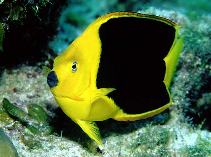| Family: |
Pomacanthidae (Angelfishes) |
| Max. size: |
35 cm TL (male/unsexed) |
| Environment: |
reef-associated; marine; depth range 3 - 92 m, non-migratory |
| Distribution: |
Western Atlantic: Georgia (USA), Bermuda, and northern Gulf of Mexico to Santa Catarina, Brazil (Ref. 57756). |
| Diagnosis: |
Dorsal spines (total): 14-14; Dorsal soft rays (total): 17-19; Anal spines: 3-3; Anal soft rays: 18-20. Front of body yellow; remaining parts of body, dorsal fin, and front of anal fin black. Caudal fin entirely yellow (Ref. 26938). Front margin of anal fin and edge of gill cover orange; bright blue on upper and lower part of iris. The young of about an inch in length are entirely yellow except for a blue-edged black spot on the upper side of the body posterior to the midpoint; with growth the black spot soon expands to become the large black area covering most of the body and dorsal and anal fins (Ref. 13442). |
| Biology: |
Inhabits rock jetties, rocky reefs and rich coral areas. Juveniles often associated with fire corals (Ref. 9710). Feeds on tunicates, sponges, zoantharians and algae. Marketed fresh (Ref. 3797). |
| IUCN Red List Status: |
Least Concern (LC); Date assessed: 08 October 2009 Ref. (130435)
|
| Threat to humans: |
reports of ciguatera poisoning |
Source and more info: www.fishbase.org. For personal, classroom, and other internal use only. Not for publication.

